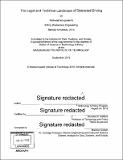The legal and technical landscape of distracted driving
Author(s)
Mongkolsinh, Natharat.
Download1111801871-MIT.pdf (11.31Mb)
Other Contributors
Massachusetts Institute of Technology. Institute for Data, Systems, and Society.
Technology and Policy Program.
Advisor
Nicholas A. Ashford.
Terms of use
Metadata
Show full item recordAbstract
In the year 2016, distracted driving contributed to 9% of fatal crashes, killing 3,450 people in the United States. While non-technological distractions are a significant concern, this thesis focuses on technological activities that have a unique technology-based risk of distraction as well as present a unique possibility for solutions both through technological safe-guards and legal interventions. The activities of focus in this thesis include talking or texting on a mobile phone (both hand-held and hands-free), using a GPS device (in-vehicle and nomadic), and performing like tasks - including emailing and watching videos on fixed in-vehicle devices. The thesis explores the problem of distracted driving through an expensive literature review of the risks involved. This technical understanding lays a foundation for examining the legal response to technological distractions in the vehicle (both from in-vehicle technology and nomadic devices). The thesis explores the legislative landscape in non-U.S. jurisdictions (for example, the UK, the Netherlands, Sweden, Australia, Canada, France), the legislative landscape in U.S. jurisdictions, and state-imposed product liability and failure to warn in the U.S. It also puts forward the existing and possible educational and technological interventions which can complement legal interventions to effectively promote a change in driver behavior and ultimately safer roads. We conclude that the legal system nationally and internationally is not yet up to the challenge that the emerging technology portends.
Description
Thesis: S.M. in Technology and Policy, Massachusetts Institute of Technology, School of Engineering, Institute for Data, Systems, and Society, 2018 Cataloged from PDF version of thesis. Includes bibliographical references.
Date issued
2018Department
Massachusetts Institute of Technology. Institute for Data, Systems, and Society; Massachusetts Institute of Technology. Engineering Systems Division; Technology and Policy ProgramPublisher
Massachusetts Institute of Technology
Keywords
Institute for Data, Systems, and Society., Technology and Policy Program.